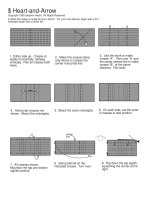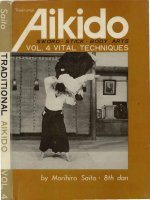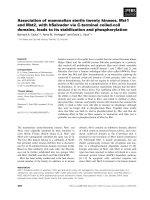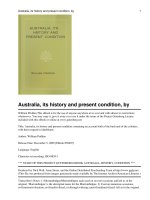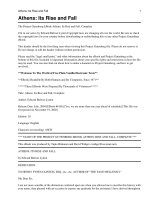Aikido its heart and apprearnce morihiro saito
Bạn đang xem bản rút gọn của tài liệu. Xem và tải ngay bản đầy đủ của tài liệu tại đây (35.18 MB, 126 trang )
Morihiro Saito
Its Heart and Appearance
SUGAWARA MARTIAL ARTS INSTITUTE, INC.
Tokyo,
Japan
AIKIDO—Its Heart and Appearance
©1975 by Morihiro Saito
All rights reserved, including the right to reproduce this hook or portions thereof
in any form without the written permission of the publisher.
Published by
SUGAWARA MARTIAL ARTS INSTITUTE, INC.
20-13, Tadao 3 chome, Machida-shi, Tokyo, 194 Japan.
Phone : (81) 427-94-0972 / Fax : (81) 427-94-0899
Distributors:
UNITED STATES AND CANADA: JP Trading, Inc., 300 Industrial Way, Brisbane, CA
94005-1009, UNITED KINGDOM AND EUROPE : Premier Book Marketing Ltd., 1
Gower Street, London WC1E 6HA. AUSTRALIA AND NEW ZEALAND : Bookwise
International, 54 Crittenden Road, Findon, South Australia 5023. THE FAR EAST AND
JAPAN : Japan Publications Trading Co., Ltd., 1-2-1, Sarugaku-cho, Chiyoda-ku,
Tokyo 101.
Fifth printing: October 1995
ISBN: 0-87040-345-1 Printed
in Japan
FopewoPd
The Aikido population keeps growing every year. Almost
everybody knows Aikido at least by name these days. Newspapers,
television and a number of publications are contributing to its
growing popularity. This is a really gratifying phenomenon.
However, when thinking about the future of Aikido 20 to 30 years
hence, we—Aikido devotees—must constantly watch its growth with
a noncomplacent attitude. Such attitude is necessary because we
must choose the optimum form and process of Aikido development in treading the path to fulfilment of the art. The task of
getting the true spirit and accurate techniques of Aikido across is
becoming increasingly difficult as the Aikido population increases,
particularly in remote areas.
This book has been published to convey to the beginner the
"heart and form" of Aikido in a simple and precise manner. We
would be most pleased if the book serves to accomplish two
parallel objectives — 1) further popularization of Aikido and 2)
correct initiation into the art. We hope the book will provide a
fruitful reading.
March, 1975
Morihiro Saito
Master of Aikido, Kisshomaru Uyeshiba (left) and the author.
Contents
Foreword
Prelude
1. TRAINING METHOD .........................................................16
1. Basic Information ......................................................................16
Manners......................... ,........................................................ 16
Moving on knees......................................................................18
How to hold sword .............................................................22
Uses of "sword-edge" of hand ..............................................24
Atemi........................................................................................26
2. Basic Movements ...................................................................... 32
Body turning
......................................................................32
Posture and Hitoemi (Reverse triangular stance)................ 34
Entering ...................................................................................37
•2.AIKI TECHNIQUES
...................................................... 38
1. Aiki Fencing Art
......................................................................38
• Sword-swinging exercise ........................................................ 38
No. 1 . . . 38, No. 2 . . . 39, No. 3 . . . 40, No. 4 . . . 41
No. 5 . . .42, No. 6 . . .43, No. 7 . . . 44
• Matching exercise ................................................................ 46
No. 1 . . . 46, No. 2 . . . 47, No. 3 . . . 48, No. 4 . . . 49
No. 5 . . .50, No. 6 . . . 5 1 , No. 7 . . . 52
2. Abdominal Breath Power Training..............................................54
• Standing .................................................................................. 54
• Against two-man attack........................................................56
• Sitting ...................................................................................... 58
3. Holding Techniques.......................................................................62
• Dai-lkkyo (Arm pin).............................................................62
Sitting; Shomen-uchi (Straight strike at the head)
Omote-waza (Front technique) ..............................62
Standing: Shomen-uchi Omote-waza ............................... 64
Sitting; Ura-waza (Turning technique) ...................-............ 64
Standing: Ura-waza ................................................................ 64
Ushiro Ryote-dori (Both hands held from behind) ............. 66
Varied exercise .......................................................................68
• Dai-Nikyo (Wrist turn) ....................................................... 69
Shomen-uchi Omote-waza ................................................. 69
Ura-waza.
.70
Mune-dori (Lower lapel held) ................................................ 72
• Dai-Sankyo (Arm twist).......................................................74
Shomen-uchi Omote-waza ................................................. 74
Ura-waza ........................................................ 75
Varied exercise........................................................................ 77
Varied exercise........................................................................ 78
Tsuki (Thrust) varied exercise ............................................. 80
Tachi-dori (Sword-taking) ................................................82
• Dai-Yonkyo (Forearm pin) ..................................................84
Shomen-uchi Omote-waza ................................................. 84
Ura-waza ........................................................85
Tachi-dori ........................................................................... 86
• Dai-Gokyo (Defense against armed attacks) ........................ 89
Yokomen-uchi Omote-waza .............................................. 89
Ura-waza ........................................................91
Varied exercise........................................................................ 92
4. Throwing Exercise...................................................................94
• Shiho-nage ........................................................................... 94
Principle of sword ................................................................94
Katate-dori (One hand held).................................................. 96
• Irimi-nage (Entering throw) ................................................... 98
Shomen-uchi.........................................................................98
Tachi-dori .......................................................................... 100
Varied exercise..................................................................... 102
• Kotegaeshi (Wrist turn-out) ................................................ 104
Principle of sword ............................................................... 104
Tachi-dori ............................................................................. 105
Tsuki ..................................................................................... 106
Varied exercise No. 1 ................................................... 108
No. 2
.................................................. 109
• Koshi-nage (Hip throw) ....................................................... 110
Mune-dori ...................................................................... 110
Ushiro mune-dori (Lower lapel held from behind) . . . .112
Ushiro Ryote-dori ............................................................. 116
• Jyujigarami (Cross-twine throw)
.................................. 118
Mune-dori ...................................................................... 118
Ushiro Ryotc-dori................................................................ 119
• Kaiten-nage (Rotary throw) ........................................... 120
inward .............................................................................. 120
• Tenchi-nage (Heaven-earth throw).................................... 122
5. Flow of "Ki"
..................................................................... 124
6. Happo-giri (Eight-corner cutting) .......................................... 126
Prelude
When asked what Aikido is, it is difficult to answer the question
in a few words. But when asked for whom Aikido exists, the
question is easy to answer. The answer simply is that Aikido exists
for those who ask for it. In a limited sense, the art exists for those
who actually practice it. Among the Aikido trainees, there are
those who, endowed with glibness, claim to know everything
about Aikido. Their actual training, however, belies their words
and is not commendable. They lack enthusiasm about their
training. I prefer the opposite type. If one examines Aikido
patiently for a long period of time, something is bound to touch
your heartstrings. That something is presumably the true answer
to the question "What is Aikido?" The answer, therefore, varies as
you continue to refine yourself. In my opinion, the answer is sort
of an unwritten law which allows all kinds of interpretations but is
something which is not forced on you by others.
In guiding his followers, Morihei Uyeshiba, the Founder of
Aikido, discouraged questions and implanted in the mind of every
trainee the attitude of using his own imagination and ingenuity.
For the imaginative trainee, the Founder provided the answers
through his bodily demonstrations which were so convincing. The
Founder certainly was not hesitant and sparingly in imparting the
essence of the art but put the emphasis of his teaching method on
encouraging the trainees to cultivate their own eyes for a deeper
meaning of Aikido. Such method, however, is no longer readily
available even if some peoply may desire it. There also may be
those who have no access to competent instructors.
Aikido officially acquired its name in 1941. By that time, the
Founder had studied and practiced all sorts of Japanese martial
arts. In inaugurating Aikido, the Founder did not identify it with a
mere consolidation of these martial arts. He created Aikido by
compounding the merits of ancient arts with the "Principle of
Aiki" and incorporating into it all the elements common to every
martial art.
Consequently, it is possible to explain Taijutsu (Empty-handed
exercise) in terms of Kenjutsu (Japanese fencing art) or vice versa.
Both Taijutsu and Kenjutsu are integrated in Aikido. Aikido
applications are so wide-ranging as to include the Jo (Stave) and
Yari (Spear). Aikido may deservedly be called an ultimate martial
art.
Aikido is unique in a number of ways, particularly in body
movements and footwork. The forms of Aikido may be equated
with Л (triangle), О (circle) and П (square). Д means creativity, О
means unlimited development and П means a state of harmony. In
other words, Л represents footwork and posture. kO represents
harmonious circular movements without conflicting with your
partner. It is a form of producing an infinite variety of techniques
at Divine will. П represents a form of integration with your partner
and indicates a successful execution of a technique. Possible
variations of П are и, 0, and И.
A semantic analysis of the word "Aikido" dictates that in
practicing the art, primary importance be attached to blending
your "Ki" (Spirit) with your partner's. Intangible Ki manifests
itself in the forms of А, О and П which guide your partner's "Ki".
If you realize this and train harder, chances are that your proficiency in Aikido will improve at a quicker pace.
For space reasons, Jo techniques have had to be omitted
entirely in this book. Those who are interested in studying a whole
spectrum of Aikido techniques are therefore advised to read a
series of books (Vol. 1, 2, 3 and 4) entitled "Aikido
Coordinated Relationship Between Ken, Jo and Taijutsu", of
which I am the author. These books, I am sure, will help you grasp the
roots of Aikido which creates an unlimited number of techniques.
CHAPTER
1
Training method
If the training method is wrong, even years of training will
fail to produce desirable results in any respectable martial
art. I therefore urge you to take due note of this point and
adopt a correct training method.
A correct training method starts with learning basic
movements, which are always practiced at each training
session, and obtaining a prior knowledge of what these
movements mean. Every time you practice, it is important
for you to try out repeatedly what you have supposedly
learned. Basic movements, which seem so simple and easy to
everyone, are quite important in that they are usefully
integrated into all Aikido techniques and serve to eliminate
unnecessary movements and unnatural conflicts as a matter
of course. Consequently, basic movements should be
practiced at each training session and should under no
circumstances be omitted. Such movements include "Body
Turns" and "Training of Abdominal Breath Power".
In Aikido, "Ki" is considered critical because it is the
origin of strength. Aikido training, therefore, is based on the
concept of building up "Ki" power superior to muscular
power. The meaning of "Ki" is extremely difficult to define.
In terms of Oriental philosophy, "Ki" is inherent in every
object in nature. No attempt has been made in this book,
however, to explore the esoteric meaning of "Ki". I have
only tried to explain Aikido movements according to the law
of nature.
1. Basle
information
• Manners
Bowing governs Aikido from beginning to end. Such
courtesy is common to all martial arts but the one observed
in Aikido is independent of others. A bow signifies a respect
for your partner and yet must be made in a state of
alertness. You are thus prepared to unleash any technique
you want. You are supposed to be on guard every inch of
yourself and ready to deal with your partner to your
advantage.
In Aikido, in particular, bowing while standing has very
much to do with standing techniques. Similarly, bowing while
sitting has a good deal of bearing on moving on your knees
and sitting techniques. In short, Aikido manners attach little
importance to formalities but take up courtesy and behavior
as a matter of spiritual exercise.
In making a sitting bow, form a triangle with your hands
within shoulder-to-shoulder span. It is desired that you
assume Hitoemi posture a moment prior to your partner's
attack and be ready to counterattack like a cat. Your
movement should be as natural as possible.
you will automatically be assuming an oblique stance.
Directional turns while moving on your knees are possible as
in the case of standing exercises. There is a great need for making
turns in Ura-waza (Turning techniques) and other techniques, as
well as in dealing with a multiple-attack.
• Moving on Your Knees
This exercise is a walk on your
knees without unbalancing the
straight sitting posture. It is a repetition of right and left oblique
movements. Turns are possible in
any direction, with the posture
remaining stabilized at all times.
When you move your right foot
forward, draw your left foot to its
trailing edge. Your body is supported by your right foot, left knee
and left foot. In this exercise, you are required to relax your
shoulders and lower your center of gravity. When you step your
left foot forward, touch your right knee slightly on the mat,
thereby maintaining a balance of the weight of your body. Please
remember that this exercise calls for walking, not on knees but on
foot. If you stand from this kneeling posture,
Top photo shows a turn rearward while moving on your knees.
Note that only the knees are turned and that the position of the
feet remains unchanged. Shown below is a turn of the feet, with
the knees staying in contact with the mat.
• How to Hold Ken
In holding a wooden sword, put your
little finger on it first, followed by your
fourth finger, middle finger, forefinger and
thumb in a gripping pattern. Direct the tip
of the sword thus held by your fingers at
your partner and blend your "Ki" with his.
Under such circumstances, your partner
will find it hard to knock the sword down.
This Ken posture is supple and yet hard in
its inner core.
Katate-dori (One hand held)
Hold the hand of your partner in a Kengripping manner.
Uses of Tegatana ("Sword-edge" of hand)
When you thrust forward the edge portion of your Tegatana
without bending your arm, the arm will naturally form an arc
permitting your "Ki" power to issue forth. Tegatana, in itself, is
not intended for aggressive purposes. It rather is used in a great
number of techniques to make better use of consolidated "Ki"
power. Tegatana's applications are far and wide according to
directional changes. For instance, Tegatana can be used as an
instrument to hold down your partner's hand in securing a hold on
it. Other uses include Atemi (A body blow prior to applying a
technique), disengaging or unbalancing your partner's hold and
gluing his hold to your wrist while swinging up your arm or sword.
Atemi is not intended for destructive purposes. It serves to keep
your partner's power in check and makes it easier for you to start
throwing or holding techniques. There is a case, for instance,
where you deliver Atemi to your partner's face and initiate a
technique without giving him a chance to mount an attack with his
hands. Photo shows how Atemi is delivered when your partner
tries to hold your lower lapel. Note that Atemi synchronizes with
the oblique turn of the body. Atemi should zero in on the most
vulnerable spot of your partner.
When the distance between you and your partner is
short, turn your Tegatana, jerk up his elbow from below
and foil his thrusting attack while delivering Atemi at the
same time.
Atemi must always be synchronous with your move to deflect
your partner's attack. A moment of hiatus between parrying
your partner's attack and delivering Atemi could result in his
possible escape.

